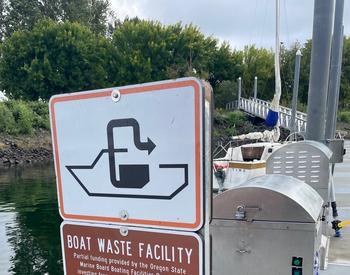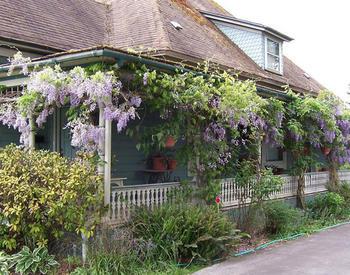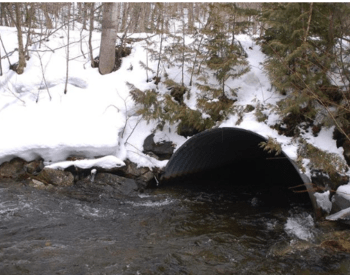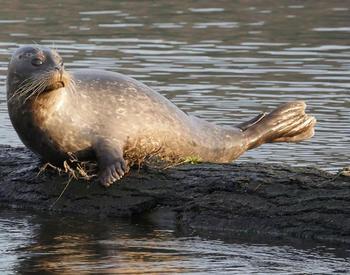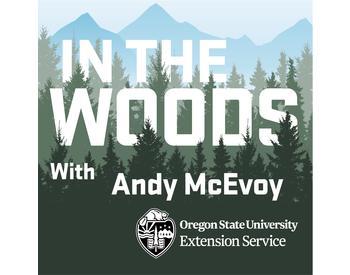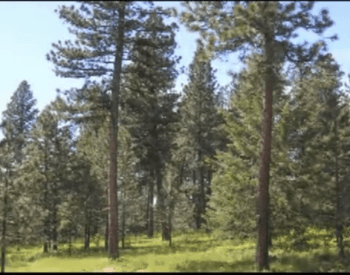Transcript
From the Oregon State University's Extension Service, you are listening to In The Woods with the Forestry & Natural Resources Program. This podcast aims to show the voices of researchers, land managers, and members of the public interested in telling the story of how woodlands provide more than just trees, they provide interconnectedness that is essential to your daily life. Stick around to discover a new topic related to forests on each episode.
Jacob: Hello everyone and welcome back to In The Woods Podcast, presented by the Forestry & Natural Resources Extension Program at Oregon State University. I am your host, Jacob Putney, Assistant Professor of Practice and Extension Agent in the College of Forestry. This month's episode is going to cover all things water, including how forests are crucial for providing clean water, some of the protections that are in place to protect streams and riparian areas, and the impacts of wildfire on stream systems and water quality. Our guest today is Dr. Kevin Bladon. Kevin is a forest hydrologist and an Associate Professor in the College of Forestry at Oregon State University. His research focuses on quantitatively exploring the impacts of land cover and land use changes on hydrology, water quality, and aquatic ecosystem health, at the hill slope, stream reach, and catchment scale. Kevin, would you like to give an introduction and tell us a little bit about yourself and some of the work that you do?
Kevin: Sure, first off obviously thanks for having me here, it's a real real pleasure. As you mentioned, I have some really broad interests, I think sort of all things water interests me and so you know I end up sort of bouncing around with a bunch of different research. Really it revolves around effects of land cover change. So human disturbances things like forest harvesting, or natural disturbances things like wildfires, or forest pathogens or pest outbreaks, and then with each of those well how do they change water quantity in the stream things like peak flows, or annual water yields, or low flows, and at a summer time where it's really critical for fish habitat, and I'm also interested in the the quality component of that, suspended sediment, stream temperature, nutrients, and heavy metals and then how those two things come together the quantity - quality to affect aquatic ecosystem health. So primary productivity, invertebrates, fish, and then I'm also really interested in some transdisciplinary work where we take a larger scale perspective where a lot of those things that I just mentioned - are all effects that I would look at in the forested headwater system. Then I'm also interested in, well okay, if we see things, we see changes in our systems, do they propagate downstream and create challenges for communities and drinking water.
Jacob: That's great, we're really glad you could join us today Kevin. So let's get started on our topic here, so to kick us off can you tell us a little bit about the role that forests play in providing clean water?
Kevin: Sure, our forests are so key for that clean water that we have, you know here in Oregon we're really proud of our our water. It was one of the first things that struck me when I first moved here is how so many people felt this empowerment, or you know felt we have the cleanest water in the U.S., and so much of that is related to the role that forests play in cleaning that water. So our forests provide a number of different things, one obviously is erosion control, and so by having broad and deep root systems in the near stream zone they really help to hold soils together. The canopies themselves, we have closed canopies, well if you have rain events and the rain falls that a lot of that rain hits the top of the canopy rather than striking the forest floor or the soils. Then associated with our forests we end up with a fairly deep organic layer on top of that soil, and so all of that together really protects and holds those soils together and stops erosion and sediment from moving into our streams. Our forests also provide a lot of shade and help to keep stream temperatures cool and in temperatures that are conducive to good fish habitat. The roots themselves can intercept and take up nutrients, take up a lot of heavy metals as well, and so we see that with some disturbances that, like a fire, all of a sudden we've got this release of certain heavy metals into our stream. Well, how, where did they come from? Well those were really taken up and held and bound tightly by our forests, and so it's not until we have these disturbances that we see those sorts of chemical elements moving into our streams. The other thing which is really important to think about, our forests themselves really are responsible for a water turnover, and a lot of water through transpiration. So transpiration, just the water use by trees, they take it up from the soil, move it up through the main stem and out through their leaves. By doing that, and releasing that into the atmosphere, they really change the amount of water in the atmosphere and can influence the precipitation regimes in other forests, and so by that then really influencing the water availability that we see in different forests as we move from west to east across Oregon.
Jacob: That's great, that's really interesting. So when thinking about that, and filtering some of that water, and kind of these areas around the stream or the areas between the forest and the streams themselves they're kind of like the riparian areas, how are those areas protected and should they be viewed differently than the rest of the forest area?
Kevin: Yeah sure, you know, riparian areas - there's been a lot of healthy debate and discussion about those trees in the near stream zone for a lot of years and Oregon is being really ground zero for a lot of that debate going back to the 1960s. Some of your listeners may remember the Alsea watershed study, just approximately an hour and a half west of Corvallis here, and really it was the first study of its kind globally to illustrate the importance of riparian areas and that study really kicked off a lot of the debate. So for those that aren't familiar with the study, back in the 60s it was a three watershed study where they had one watershed they left it alone, still to this day it remains unharvested, Flynn Creek, and then there were two other watersheds, one, Needle Branch, they harvested it using the current practices of the day, and then Deer Creek was the one that they harvested and left riparian area, left trees in the near stream zone, and that was really novel for the time. Nobody had done that, and so really they were investigating, does this matter. Certainly what they found was the watershed that had the riparian area really didn't have those large changes in stream temperature, or sediment, or nutrients, and much lesser impacts on our aquatic ecosystem health and that then really led to adoption of some requirement for vegetation in the near stream zone in the Oregon Forest Practices Act in 1970. Well since that time those policies have continued to shift, they've continued to strengthen as we've learned more about the function of those trees and obviously the things we mentioned before you know trees in the near streams are really critical for helping to control erosion and sediment, keeping streams cool for fish, and reducing nutrient delivery to streams, providing large wood, and also providing really unique terrestrial habitats. There's lots of values that we get from those near stream trees, and so yes, to your question of should they be viewed differently, yes I think we need to treat those areas differently as they have those really unique functions. Where I think there's still a lot of debate and room for us to gather more information is well, how much retention is enough? And how much is too much? Because actually we've seen in some places we can leave too much vegetation and we can over-shade the streams and you go in there and it's like wow there's no primary productivity, there's no inverts, in those areas and actually you've created conditions that aren't conducive to fish habitat. So for us really now it's we're trying to strike that balance and figure out where that is and so there's, it's one of those areas, like I said, it's a really contentious, healthy debate around riparian areas and a lot of tug and pull there. But really when we reflect back to practices of the 1960s we've come a long way, and really, you know, really mitigated our impacts. I do think there's still lots of room for us here to continue to tweak how we treat those riparian areas.
Jacob: Yeah definitely. It always seems that we're always kind of evolving and as we come up with new ideas and find out new information. So speaking of the Oregon Forest Practices Act, and some of the protections on those stream areas that you mentioned coming out of those early watershed studies. So say I owned a woodland and there was a stream running through my forest, what protections and what considerations would I have to do to protect that stream, you know what specific rules are mentioned or outlined in the Oregon Forest Practices Act?
Kevin: Sure yeah. I'm a private landowner myself and I actually have two streams that run through my property and so I'm familiar with the private landowner requirements around this. As well as our industrial partners. But really, you know, private landowners that might have streams, they are required to inform the State of any type of logging activity or active forest management plans that you might undertake in the near stream zone. It doesn't mean in those cases that, actually the State doesn't have the authority to grant or deny approvals for the small homeowner properties, but they want to know and they want to know what's going on. Having said that, you know any type of management plans or logging that that might happen, or sort of active management that people undertake on their own property, really needs to adhere to the Oregon Forest Practices Act as it pertains to riparian areas. So in that regard then we have different stream types that are out there: the Type F stream, fish bearing streams; there's Type D streams, which are streams that are just for domestic use; we have a new addition in recent years, it's an SSBT Type stream, these are small, medium Type F streams, they're fish bearing but they're for specifically for salmon, steelhead, and bull trout use; and then we have not none of the above, the Type N stream and those all get treated differently. We also, we'll also want to look at the stream sizes and how much water is actually in that streams and there are three different categories of stream sizes: a small, medium, large, based on the cubic feet per second, that average amount of annual stream flow that that the stream conveys. Obviously most of our streams don't have gauges, we can't measure them, so we have some rules of thumb around the width of the stream that can allow us to pinpoint - is it a small? is it a medium? is it a large type stream? So those things come together then, it's a F, D, N, or SSBT, and then are those small, medium, large, and those then really define and tell the manager - landowner - okay how much riparian area do I need to retain. How wide does that have to be, and it goes anywhere from no retention at all for a Type N stream, so it's not for domestic use, or fish, and it's small, all the way up to 100 feet if you had a large fish bearing stream - you would need to retain 100 feet of width. Then there's, you know, other little rules in there that folks could look up if they were interested. Lots of little nuances to the riparian areas, but those are sort of the general idea.
Jacob: Yeah we'll be sure to post those rules on our website after this episode too so folks can check that out if they're interested in learning more. So what about wildfire? So what happens to a stream if a fire burns through a forest, including the areas around the stream, or the drainage system?
Kevin: Yeah, yeah as I, you know, as I said at the outset you know one of the areas of research that I'm most interested in, and I think there's still a lot of unknowns in this area about the effects. Because it's an area I'm interested in this has been one of the busiest years I've had in my career, with the fires we had last year in Oregon. A lot of questions about what are the likely effects, how long are they likely to last, and there's a lot, and a lot that we're still learning. So in general you could think of a fire as it comes through it's going to remove the forest canopy, and so by removing the forest canopy, every time we have a rain event, that's more rain that's hitting the forest floor. Also as that fire's gone through well it's probably burned the organic matter in the understory, and burned out a lot of the roots, and so a lot of our soil structure is lost and the soil isn't held together in the same way. So you've got more water that's hitting the forest floor, the forest floor isn't taking up that water nearly the same way, you've lost the trees that are also taking up the the water, and so what we tend to see in our streams is more water more often. We see more peak flows, greater annual water yields, the timing of availability changes as well. So for folks that are downstream and running reservoirs or dams, they're receiving that water much earlier in the season than they typically do. That also has important implications for aquatic ecosystem health. All those things, also you've got more water hitting the forest floor more often, well leads to more erosion. We end up with a lot of of sediment in our streams and with that it can bring nutrients, things like nitrogen, and phosphorus, and carbon, and heavy metals. I've seen heavy metals anywhere from doubling to 2500 times more in our streams after a wildfire. Then all of those changes can lead to changes in our aquatic ecosystems. We often see more primary productivity, shifts in our invertebrate communities, shifts in our fish - they'll often benefit from this and that well there's more invertebrates, more food for them, we can see larger fish in our streams. So number of effects and then those effects like I said at the outset can propagate downstream and really create costly challenges for our communities to make water safe to drink for folks. All of those effects can last anywhere from a couple of years to multiple decades, we've seen effects lasting up to 30-40 years after a wildfire.
Jacob: That's a long time. So do you start to see a decline in some of those effects after some of say, the early successional species start to get established? And what about the other effects? Are there ways to mitigate those?
Kevin: Yeah certainly. I think some of the research that we've undertaken has really clearly illustrated that what we do after fires matters. You know our decisions that we make whether it be salvage logging, or reseeding, or replanting, or putting things onto the landscape like mulches, or you know any of the other erosion barriers that might be available to us to stop that movement of materials off of hill slopes and into streams. All of those things matter, and I think the biggest thing for us is to try to establish some sort of vegetation on these sites as quickly as possible. It's not always as easy as it might seem, because of the changes to the soil structure, the loss of the organic matter, there are a lot of situations where depending on the fire severity that recovery can be really delayed. I've got some research sites in the Rocky Mountains that we've been studying for 15 years and there are locations within the watershed in the near stream zone that we have no re-vegetation as of yet. Because that fire burned through so hot it consumed all the organic matter, it consumed all the mineral soil, there was nothing left for any type of seed to establish in, and that's really delayed the recovery. But certainly the biggest thing for us is to try to get some vegetation re-established on those sites as quickly as possible.
Jacob: Wow, so say one of my objectives as a landowner, whether a fire went through or not, was to improve water quality. You know within my forest property, or the stream that runs through my forested property, you know what kind of things could I do to prevent things like sediment from entering the streams, or prevent like increasing stream temperatures?
Kevin: Sure, yeah I think whether it's burned or harvested or if you're just looking for simple maintenance, I think the key is to me is vegetation, organic matter, in that near stream zone. You know our forests, especially in the Pacific Northwest, have some of the highest infiltration capacities on the planet, So by that what I mean is when you pour water onto those soils it enters into the soil very rapidly and moves through that soil. You know where I've worked in other locations, where you might see with a very infrequent large precipitation event that water might flow over the surface, that is a very very rare occurrence in our forests, and a lot of that has to do with just a really nice organic matter that we have in the understory, the roots from the soils, which help to create opportunity for water to enter and move through the soils. So really the key is maintaining that vegetation, maintaining canopy cover, obviously if folks have a disturbance, maybe we have a wind event and have some blow down and now you've got an opening in your canopy and you've got a tree tip that's exposed soil that could move into your system. Which I've seen before. You know simple silt fences are really effective at capturing that sediment and you know not very costly, easy to maintain, easy to establish, and so for those types of small acute disturbances there are options out there. The one other thing I would add too, one of our biggest issues with water quality, is linear features. You know if we were undertaking some sort of activity and dragging trees across the landscape to get them to a landing or get them away, you know those linear features tend to be major sources of sediment. If we have roads, ATV crossings, there's lots and lots of landowners maybe have an ATV that you're moving across their landscape, with those places where they are continually crossing have really been shown to be locations that can really mobilize a lot of water quality constituents of concern. So just some small investments into the little bridges, and disconnecting those linear features from streams, is a good practice.
Jacob: That's interesting, I hadn't really thought about the linear features aspect before. So kind of going back to vegetation, and thinking about things like climate change. What could climate change do to water systems and impacts to water quality and things like that?
Kevin: Yeah sure. I think that's going to be a big challenge we're going to deal with here in the near future. If you just simply google the Sierra Nevada, California, and drought and forest dieback, and see some really stunning pictures of their forests - mass mortality of forests. So I think with increasing temperatures, drier conditions, associated with climate change, I think there's a lot of questions of are forests going to have enough water to meet their demand. Will we have some of that large scale dieback, and if so, what does that mean for all the things we've just talked about with increased erosion, and water availability, and streams, and that shading component. Myself, as a landowner, I've watched a lot of my trees dying back slowly from the tops from the, you know, consistently drier conditions that we've had here, and so really raises concerns for me the long term. The other thing related to that, if our trees are able to survive, with drier conditions in the atmosphere, this is a cool question that's come up and a lot of uncertainty around it; those trees that are there, with drier air around them, that air that's drier has a greater evaporative demand, and so by having a greater evaporative demand, that means it's going to mobilize and move more water through our trees. Our trees will transpire more, if they do survive, and can't tap into and access whatever water is there, and if so, what does that mean for water in our streams in terms of summer low flows, and fish habitat, and we've already seen some evidence that in some systems where we've been fortunate enough to have 30, 40, 50, 60 years of data, we've started to see summer low flows go into a deficit - where we've got less water in the stream than we had historically during that that summer low flow period. So yeah lots of things to consider obviously with climate change, we've got potential for more wildfires as well, and all the issues associated with that, and I guess I think that's a big challenge we've gotta address here in the near future especially with some of our our forest management decisions.
Jacob: Yeah definitely, I think there's just too many things to consider when thinking about climate change and so many questions we still need to answer. Well you know I think that was just a really great, huge overview on water systems and forests, there's obviously so many different things you could cover. But I mean is there anything specific else you'd like to talk about related to streams, or some of your research?
Kevin: You know, the only thing I'll leave your listeners with is I would encourage them to be in forests and be near water on a regular basis. You know there's, you talk about all these effects and things happening, but really you know I think it's key for all of us to spend some time out near water. I don't know if you're familiar with this, but there's a book called, oh I'm gonna forget it now sorry I'll come back to it, but there's a recent study by neuroscientists and psychologists and what they clearly showed is that our brains are really actually hardwired to react positively to water. They showed this by putting people in and near water and following their brain patterns and really showed that being around water helps to calm us down, to connect us, it increases our innovation and brain power and insight, and it's just a really healthy thing. So you know I think just for your listeners to just think about how they feel when they're, you know, near the ocean or near a babbling brook, water is a pretty powerful element and so I would suggest that folks spend time near water as much as possible.
Jacob: Yeah that's really interesting! I'll have to track down the title of that book and I'll get it posted on our website.
Kevin: Sure, I did remember it. It's called Blue Mind, it's a book by Wallace Nichols.
Jacob: Alright I'll be sure to put a link to that on our website.
Kevin: Yeah, great.
*Transition to Lightning Round*
Jacob: Well thank you so much for joining us today, Kevin. There's probably a lot more that we could have covered, you know water is such an important resource, and you know forests play a crucial role in providing clean water to communities. So as you're listening today, if any questions came up or we didn't cover a specific topic related to water, you know please drop us a comment or send us a message on our website at blogs.oregonstate.edu/inthewoodspodcast. Kevin maybe we could talk you into joining us again to spend some more time talking about water and the results of some of your research. As we start to wrap up here, we have a few questions we like to ask each of our guests. So the first one here is what is your favorite tree?
Kevin: These are dirty questions because..
Jacob: I know asking the hydrologist what his favorite tree is.
Kevin: This is a difficult question. You know obviously I've grown to love Douglas-fir more and more. It's such a part of the fabric of the Pacific Northwest, and so it has a piece of my heart. Sitka spruce, I read the book by John Vaillant called The Golden Spruce, and fell in love with Sitka spruce with just from that book. Done some research in California on western red cedar and just loved that. But I guess if I had to pick one, it would be Ponderosa pine, and I love the smell of a Ponderosa pine forest on a hot summer day, and nothing like that bark is like the puzzle pieces and yeah, that's my favorite.
Jacob: Well good, good I'm fortunate enough to spend a lot of time out in the Ponderosa pine forest here in eastern Oregon, so I'm glad to hear that. So the next question here is, what is the most interesting thing you bring with you in the field, whether in your cruiser vest or other field kit?
Kevin: Yeah sure, I love my cruise vest it's like a Linus blanket for me. I feel uncomfortable in the forest without it, even if I don't need it, I'm always bringing it, I'm wearing it, I love it. It's got so many cool things in it that I love. Boy I've got this small solar calculator in there that I've had for about 17 years and it's just been with me through so many things, I love that, but my favorite is this something I got more recently that my wife bought me and it's this little clip-on watch. Clips on to, and so I've always got the time, and that watch has a little mini flashlight on it for those long field days when it's getting dark and you can find your way, it's great.
Jacob: That's great, I remember I had a calculator in my cruiser vest at one point, but doing too many field work in the winter in western Oregon, I think the rain finally did it in. So the last question we have here is, you know, what resources might you recommend for our listeners if they want to learn more about water quality, or stream protection rules, I know we mentioned the Forest Practices rules, or the effects of wildfire and climate change on water systems?
Kevin: Sure, you know obviously I think podcasts like this are a great start, so thanks for having me. Otherwise, you know, certainly the Oregon Forest Practice, protection laws, there's that illustrated manual if folks haven't seen that, it's a great one, I think it's on the third edition right now. You know just a real easy read for folks that have not been introduced to these sorts of things, does a really nice job of going through the stream protection rules, so you know that's a great great place to start. I do think there's also a number of publications that came out when the Watershed Research Co-op was still running at the College of Forestry at OSU. So a lot of those resources are available on the Watershed Research Co-op website, and sort of get them out from behind the pay walls, and made them available to people, there's some great resources there. Then other than that, I guess off the top of my head, there's some great and classic books on water that I would recommend. One of them, The Oregon Water Handbook, for me it was a great introduction to just everything water in Oregon. Then things like The Good Rain by Timothy Egan; there's Cadillac Desert a book by Mark Reisner; and then a more contiguous U.S. book is The Big Thirst by Charles Fishman, and all of those I would recommend to give folks an introduction to all things water.
Jacob: Those all sound great I'm gonna have to read some of those as well, and that illustrated guide is really good too. I still reference that all the time and when I need to look something up.
Kevin: It's great.
Jacob: Well thanks again for joining us Kevin. This concludes our seventh episode of In The Woods Podcast. Join us again next month to talk about climate and the effect it has on forests and what changes we might expect into the future. Bye everyone.
Thanks so much for listening! Show notes with links mentioned on each episode are available on our website: blogs.oregonstate.edu/inthewoodspodcast. We'd love to hear from you! Visit the "tell us what you think" tab on our website to leave us a comment, suggest a guest or topic, or ask a question that can be featured in a future episode, and also give us your feedback by filling out our survey. In The Woods is produced by Lauren Grand, Carrie Berger, Jacob Putney, Stephen Fitzgerald, and Jason O'Brien, who are all members of the Oregon State University, Forestry & Natural Resources Extension team. This podcast is made possible by funding from the Oregon Forest Resources Institute. Music for In The Woods Podcast was composed by Jeffrey Hino, and graphic design was created by Christina Friehauff. We hope you enjoyed the episode and we can't wait to talk to you again next month. Until then, what's in your woods?
In this episode, Jacob Putney is joined by Dr. Kevin Bladon to discuss how forests are crucial for providing clean water







